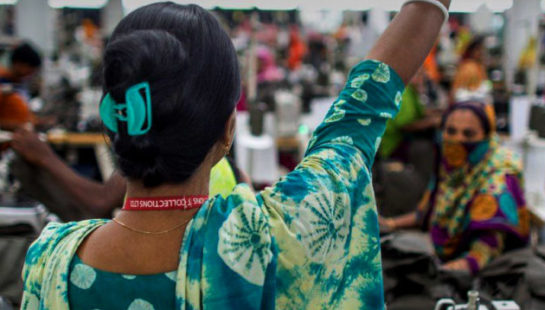What Does Life Look Like For Garment Workers In A Post-COVID World?
At a basic level, families around the world all need and deserve the same thing – to put food on the table and to live in safety. For the world’s most vulnerable, unemployment and poverty make it a constant struggle to meet even these most basic needs. For many, migration offers the promise of a better life; greater employment prospects and crucial funds to support their family. Migrant workers often move away from their families, sending a large portion of their wages back home as remittances. These funds play a vital role in alleviating poverty in low and middle-income countries (LMICs) and can lead to higher spending on education, better nutritional outcomes, and lower rates of child labour. Global remittances to LMICs reached a record $554 billion in 2019, making them greater than foreign direct investment.
We cannot underestimate the critical role that the world’s 164 million migrant workers play in helping to achieve poverty reduction targets.
Despite this, migrant workers continue to be undervalued and underpaid. Discrimination, unstable legal status, and inadequate social protections place this group at significant risk of exploitation. Industries relying on low-cost, low-skilled labour create a particularly hazardous landscape for these workers, and it’s a climate that is made much worse by the unfolding COVID-19 pandemic.
Challenges In The Garment Industry
The garment industry is just one case study that exemplifies the vulnerabilities of migrant workers. Many similar, low-skilled industries face the same challenge. Garment-producing countries such as Malaysia, Thailand, Jordan, and Taiwan have high proportions of migrant workers. As fashion companies continue to push for lower costs and shorter lead times, these workers are particularly susceptible to exploitation.
At the core of this exploitation is poor legal protection. Migrant workers may be documented or undocumented. Both face different, but significant, risks. Undocumented workers are particularly vulnerable as they usually have no access to legal protection. In Turkey, for example, undocumented Syrian refugees have been discriminated against as their employers fail to pay the legal minimum wage. Their undocumented status makes it near impossible to make any legal claim against this injustice.
Documented workers are also vulnerable as their legal status in the host country depends on their employment. This creates an environment where exploitation can run rife, as speaking out against mistreatment may result in unemployment and, ultimately, deportation. Employers may retain workers’ identity documents to restrict their movement, effectively trapping the worker in forced labour. Additionally, national social protection and healthcare provision is often not extended to migrants, adding an extra layer of vulnerability.
Migrant Works Also At Risk Of Exploitation
Migrant workers may also be unaware of their rights, or unable to act upon them. In many parts of the world, migrants are prohibited from taking up positions in trade unions. For those who are permitted to unionise, conflict with local members is a barrier to effective engagement. Migrant workers are rarely included in union leadership, and the poorer conditions of their employment are sometimes considered a threat to improving the pay and conditions of local workers. Even where workers can unionise, fear of retribution or deportation effectively silences their concerns.
The process of gaining employment across borders is complex, often involving multiple contracts and a tangled web of recruitment agents, brokers, and employers. There is a lack of visibility regarding who holds responsibility for the wellbeing of the worker and their employment. It is common for migrants to go into debt to cover the (often excessive) costs of recruitment, visas, and travel. The result is bonded labour – an employment arrangement where the worker is unable to leave their job out of obligation to repay these fees. This precarious employment is endemic across the global garment industry.
What Will Happen To Migrant Workers During The COVID Pandemic?
These challenges will only be exacerbated by the COVID crisis.
National policy responses such as unemployment benefits and wage subsidies frequently exclude migrant and informal workers. For those who lose their jobs, this may result in the expiration of visas and work permits, meaning that their ability to stay in the host country is at risk. Global remittances to LMICs are expected to decline by almost 20% this year.(1) And it’s important to recognise that it’s not only the worker who is disadvantaged by their loss of income, but also their whole family or community in their country of origin.
There are unique challenges in accessing health care, including cultural and language barriers, cost limitations, and non-inclusive health policies. Workers who are undocumented or of any irregular status may be unable to access services for fear of deportation. These challenges are not exclusive to the crisis, but they will have particularly dire consequences for those who are not able to access coronavirus testing and treatment.
Lastly, migrant workers are severely affected as movement is restricted within and between countries. Workers may be trapped in their host country without any option to return home and reunite with their family. Alternatively, workers who had an employment contract in place may be unable to travel to commence that arrangement, thus making repayment of incurred costs more difficult.
What Can Fashion Companies Do To Support Migrant Workers?
We are calling on fashion companies to support vulnerable workers at all times, but especially during this coronavirus pandemic. We have asked companies to commit to the COVID Fashion Commitments, which include identifying, listening to, and supporting workers (such as migrant workers) who face unique risks.
Fashion companies can facilitate fair conditions for migrant workers by:
- Providing specific provisions for migrant workers that focus on rights rather than legal status in company Codes of Conduct and other policies.
- Conducting proper monitoring and risk assessments to understand where there are migrant workers in their supply chain.
- Monitoring for the use of labour brokers and recruitment agents in production facilities.
- Enforcing an ‘employer pays’ approach to covering the cost of recruitment fees and government levies.
- Providing suitable training to both suppliers and workers on rights and safety at work.
- Prohibiting the use of forced labour in any form, including the retention of worker identity documents.
Will you join us in standing with workers by calling on fashion brands to make these important commitments?
Image licensed under the Creative Commons Attribution-NonCommercial-NoDerivs 3.0 IGO License. To view a copy of this license, visit creativecommons.org/licenses/by-nc-nd/3.0/igo/deed.en_US.



 Baptist World Aid
Baptist World Aid
